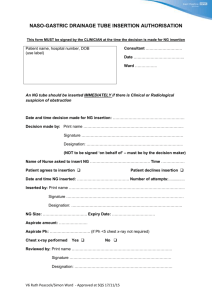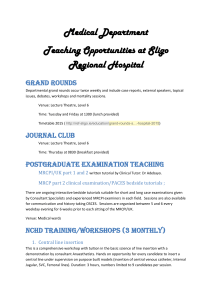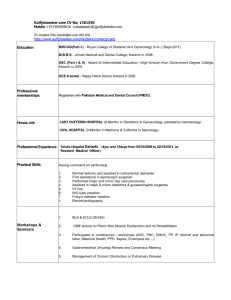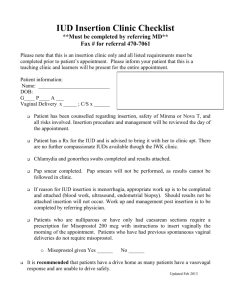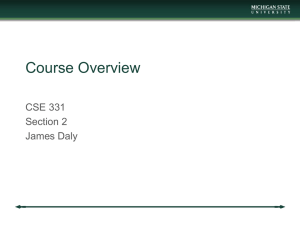Student Instructions from Laboratory Manual
advertisement
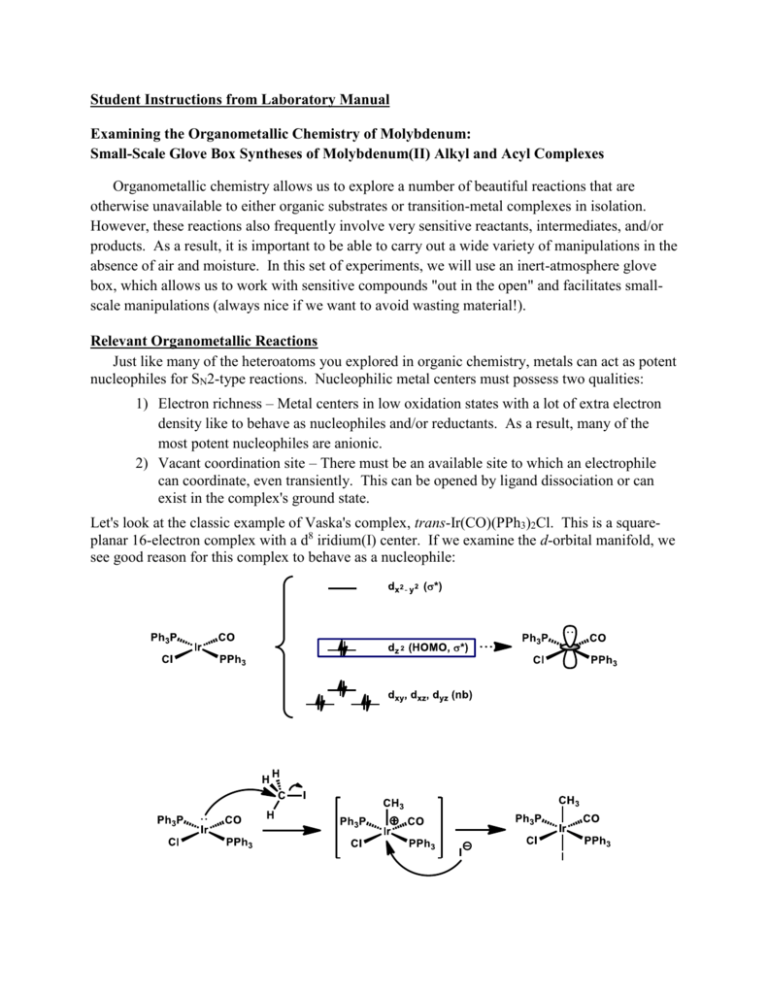
Student Instructions from Laboratory Manual Examining the Organometallic Chemistry of Molybdenum: Small-Scale Glove Box Syntheses of Molybdenum(II) Alkyl and Acyl Complexes Organometallic chemistry allows us to explore a number of beautiful reactions that are otherwise unavailable to either organic substrates or transition-metal complexes in isolation. However, these reactions also frequently involve very sensitive reactants, intermediates, and/or products. As a result, it is important to be able to carry out a wide variety of manipulations in the absence of air and moisture. In this set of experiments, we will use an inert-atmosphere glove box, which allows us to work with sensitive compounds "out in the open" and facilitates smallscale manipulations (always nice if we want to avoid wasting material!). Relevant Organometallic Reactions Just like many of the heteroatoms you explored in organic chemistry, metals can act as potent nucleophiles for SN2-type reactions. Nucleophilic metal centers must possess two qualities: 1) Electron richness – Metal centers in low oxidation states with a lot of extra electron density like to behave as nucleophiles and/or reductants. As a result, many of the most potent nucleophiles are anionic. 2) Vacant coordination site – There must be an available site to which an electrophile can coordinate, even transiently. This can be opened by ligand dissociation or can exist in the complex's ground state. Let's look at the classic example of Vaska's complex, trans-Ir(CO)(PPh3)2Cl. This is a squareplanar 16-electron complex with a d8 iridium(I) center. If we examine the d-orbital manifold, we see good reason for this complex to behave as a nucleophile: The transformation shown above (formal addition of CH3–I to iridium) is part of a larger class of organometallic transformations known as "oxidative addition", so called because the formal oxidation state of iridium increases from +1 to +3 due to donation of the lone pair of electrons to the nominally more electronegative methyl group. In fact, one way to think of it is that oxidative addition is any reaction when a compound X–Y adds to a metal complex, breaking the X–Y bond and forming either one or two new bonds (in this case, the new M-CH3 and M–I bonds). Generic Oxidative Addition Scheme A second class of organometallic transformation we will examine in this laboratory, known as "migratory insertion", involves the insertion of an unsaturated group attached to a transition metal into an M–X bond. Two commonly encountered variants are (a) the insertion of an alkene into a metal–hydrogen bond, and (b) the insertion of a carbonyl ligand into a metal–alkyl, both shown below: Common Migratory Insertion Reactions Both oxidative addition and migratory insertion reactions have rich varieties of specific mechanisms available, making them extremely interesting subjects for kinetic studies. For now, we will focus on a few important details of the migratory insertion process by examining the case study of Mn(CH3)(CO)5. First, you'll notice that migratory insertion opens a coordination site on manganese. It is a reversible process and, in this case, the 6-coordinate "uninserted" product is strongly favored in the equilibrium. So, how do we favor the migratory insertion product? As mentioned above, the insertion reaction opens a coordination site, so we can increase the concentration of the inserted product in the equilibrium mixture by using a sufficiently coordinating solvent (typically acetonitrile, ethers also work… designated as S below). We can also "trap" the inserted product using a strong coordinating ligand such as phosphine. When used in combination, these techniques will accomplish our goal. The large excess of solvent that is present will increase the equilibrium concentration of the inserted product, allowing it to be trapped by phosphine (which would be prohibitively slow in the absence of a coordinating solvent due to the low concentration of inserted product). Organometallic Chemistry of Molybdenum In this laboratory, we will be examining both of the reaction mechanisms shown above using (cyclopentadienyl)molybdenum polycarbonyl complexes. We will begin by generating a nucleophilic molybdenum(0) anion that will engage in SN2-type chemistry with methyl iodide. Note that the equations below are not fully balanced. You should think about what the other byproducts of each reaction are, and it may help to begin by assigning an oxidation state to molybdenum in each species. [Mo(CO)3(η5-C5H5)]– ½ [Mo(CO)3(η5-C5H5)]2 + LiEt3BH THF [MoMe(CO)3(η5-C5H5)] [Mo(CO)3(η5-C5H5)]– + MeI THF Once the molybdenum methyl has been prepared and purified, we will attempt to prepare migratory insertion products using a variety of phosphine ligands. A generic scheme for the reaction we will attempt is shown below. We have previously examined this reaction for triphenylphosphine and methyldiphenylphosphine, though we have a number of other secondary and tertiary phosphines at our disposal for trying new reactions! Possibilities include: triphenylphosphite, diphenylphosphine, dicyclohexylphosphine, tri-2-furylphosphine, and tricyclohexylphosphine. Your charge is to characterize the molybdenum methyl complex and your hopeful insertion product by a variety of methods, including IR and 1H, 13C, and 31P NMR spectroscopies. For groups that make new complexes, we will attempt to crystallize the products for characterization by X-ray crystallography (though this will likely occur after the end of the term). All of these techniques will hopefully allow us to assign the stereochemistry of our products. Synthesis of [MoMe(CO)3(η5-C5H5)] and its Migratory Insertion Derivatives This procedure is adapted from “Synthesis of Metal Carbonyl Monoanions by Trialkylborohydride Cleavage of Metal Carbonyl Dimers: A Convenient One-Flask Preparation of Metal Alkyls, Metal Acyls, and Mixed-Metal Compounds” by Gladysz, J. A.; Williams, G. M.; Tan, W.; Johnson, D. L.; Parker, D. W.; Selover, J. C. Inorganic Chemistry 1979, 18, 553558. NOTE: When using methyl iodide (or any volatile halogenated compound), you should be sure to turn off the glove box purifier and purge the box afterward to avoid irreversibly halogenating the copper catalyst! WEEK 1 Synthesis: In an inert-atmosphere glovebox, dissolve 150–200 mg of [Mo(CO)3(η5-C5H5)]2 in anhydrous THF (ca. 10 mL) in a 20-mL scintillation vial equipped with a flea-sized magnetic stir bar. With vigorous stirring, slowly add 2.5 equiv of lithium triethylborohydride [aka, SuperHydride®] (1.0-M solution in THF) by syringe, cap the flask, and allow the reaction to proceed for 20 min. Add 3 equiv of methyl iodide slowly by calibrated micropipette and stir the resulting reaction mixture for 2 h. Remove the volatiles in vacuo with stirring using the "suckers" in the glove box and store the crude product in the freezer until the next lab period. Disposal & clean-up: The solvent collected in the traps contains triethylborane; this should be moved to a fume hood and transferred to an appropriately-labeled non-aqueous organic waste container when you take down the traps. The syringe used for Super-Hydride should be rinsed with anhydrous THF in the glove box before removing and discarding in the trash. Methyl iodide is toxic, so the pipette tip used for methyl iodide should be placed in the appropriate sealed bottle in the glove box and moved to a fume hood for disposal after use. WEEKS 2 & 3 Purification of CpMo(CO)3(CH3): Extract the solid from Week 1 into pentane (ca. 4 × 10 mL portions, or until colorless) and filter the solution through a short plug of Al2O3 (ca. 1 – 1.5 cm in a 15-mL frit). Wash the alumina with extra pentane until the eluent is colorless. Remove the solvent in vacuo to afford (hopefully) pure methylated product. Record the mass of the product to determine yield, then record the IR spectrum in CH2Cl2 and the 1H and 13C NMR spectra in CDCl3. Synthesis of [Mo(CO)2(COMe)(η5-C5H5)(PR3)]: In an inert-atmosphere glovebox, combine MoMe(CO)3(η5-C5H5) and 1.5 equiv of your phosphine in acetonitrile (10 mL) and stir for at least 24 h and up to 1 week. If a precipitate has formed, recover the precipitate by filtration, wash with pentane (2 × 5 mL) and dry in vacuo. If a precipitate has not formed, check by 31P NMR to determine whether your reaction has proceeded, and if so, remove all volatile components in vacuo, triturate the residues with pentane (5 mL), recover them by filtration and wash with pentane (5 mL) to afford your product. Whatever your method, be sure to record a yield after isolating your product. Record the solution IR spectron of the product in CH2Cl2 in the 1500–2200 cm–1 range as well as 1 H, 13C, and 31P NMR spectra in CDCl3. If you wish to further purify your product by crystallization, a good place to start is by chilling a concentrated solution of the product in diethyl ether or pentane.

